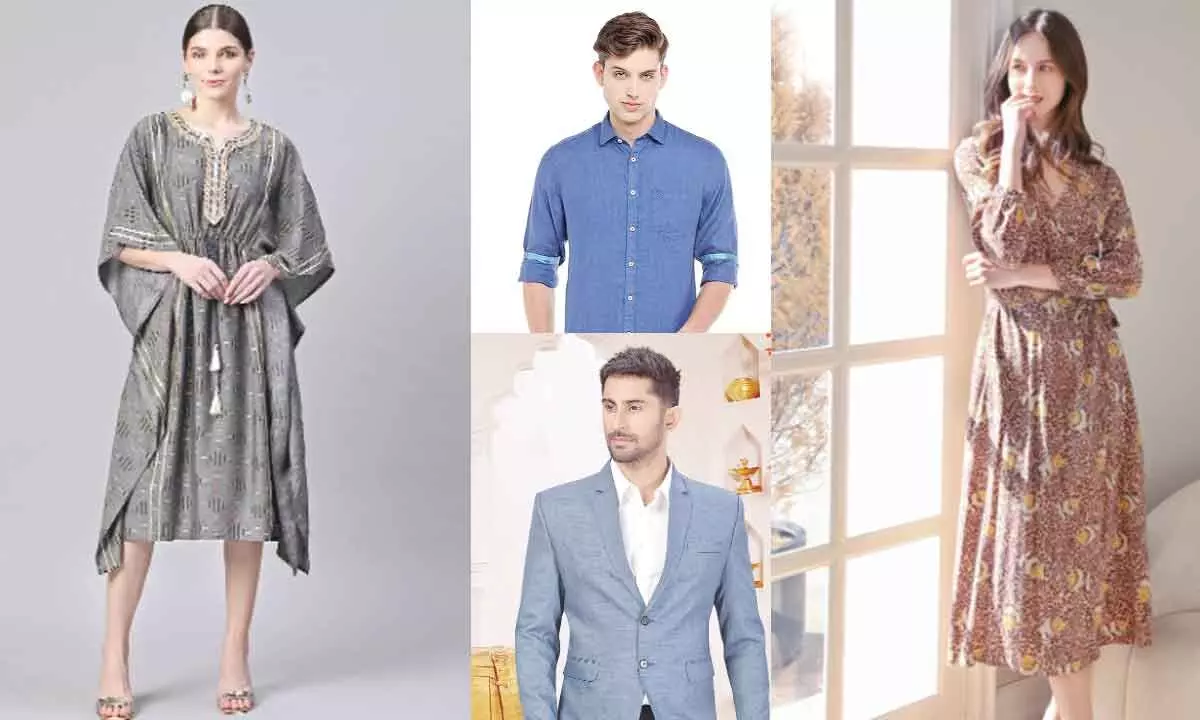Live
- PM Modi to attend Christmas celebrations hosted by Catholic Bishops' Conference of India tomorrow
- ‘Dhop’ from ‘Game Changer’ lights up musical platforms
- Allu Arjun requests fans to stop using abusive language
- Rohit Pathak: A rising star in Indian cinema with powerful villain roles
- Pooja’s ‘final day of shot for 2024’ makes waves
- Nayini Rajender Reddy Addresses Press Conference at Hanumakonda Congress Office
- ‘Game Changer’ pre-release event in Dallas is a blockbuster
- NDMC Vice Chairman hits out at AAP's registration drive; labels it 'election gimmick'
- No place for Stokes as Root returns to England’s squad for India ODIs and Champions Trophy
- Kuwait bestows its highest honour 'The Order of Mubarak Al Kabeer' to PM Modi
Just In
Game changing sustainable fabrics


While the fashion industry is flourishing, there has been a lot of attention to the adverse environmental impact caused by the industry, responsible for 10 percent of the world’s greenhouse emissions.
While the fashion industry is flourishing, there has been a lot of attention to the adverse environmental impact caused by the industry, responsible for 10 percent of the world's greenhouse emissions. Buying clothes in abundance is appealing due to the affordability of fast fashion, but it comes at the cost of cheap labor and low-quality materials. Moreover, the wastage caused by unsold inventory and the discarding of dead stock has had troubling consequences causing water, air, and soil pollution, thereby affecting the life cycle of a living being.
As people have become more informed about climate changes, and global warming and mindful of the use of natural resources, conscious decision-making has come into play for most. In an effort to cater to the needs of the audience while being accountable for the cause of conserving the planet for future generations, the fashion industry is attempting to make textiles more sustainable by ethically, sourcing, producing, and packaging them.
To understand more about sustainable fabrics let's look at the definition of 'Sustainable Fabric'.
What is Sustainable Fabric? Sustainable clothing refers to fabrics derived from eco-friendly resources, such as sustainably grown fiber crops or recycled materials. It also refers to how these fabrics are made. with the goal of minimizing damage caused by the manufacturing process. Such fabrics can also help with waste minimization, conservation of water, carbon reduction, and soil restoration.
Linen
Linen is a plant-based natural fiber that has been used in the production of clothing for centuries. The grass-like fibers need to be grown, treated, and processed for months before they are soft and supple enough to be weaved into garments. When discarded, due to its biodegradable qualities, linen offers a more environment-friendly alternative. It is a super soft and breathable textile derived from the flax plant and is frequently blended with cotton. Linen is regarded as one of the most sustainable fabrics used presently in the production of clothing and bedding.
Bamboo
Bamboo is one of the fastest-growing, regenerative plants which doesn't need fertilization and is frequently promoted as a sustainable fabric. Micro holes and tiny gaps in its fiber, allow for better moisture absorption and ventilation than other fibers. Sustainable brands prefer bamboo fabric since it is extremely comfortable and absorbent. Just like Hemp, bamboo absorbs more CO2 than some trees. It doesn't need a lot of resources and can survive just on rainwater.
Modal
Another semi-synthetic fabric noted for its superior comfort and breathability is modal. It's a cutting-edge fabric created from spinning cellulose from the beechwood tree. As beechwood trees regenerate on their own, they're regarded as a long-term raw material for making the revolutionary modal fabric. The fabric is also 50% more absorbent when compared to cotton and has a silky, smooth texture, thus making it a suitable option for sports and underwear manufacturers. Modal's manufacturer, Lenzing, has also developed non-toxic and ecologically friendly techniques which allow it to recover up to 95 percent of the materials utilized in its production, lowering the textile's overall carbon emissions.
Viscose
Viscose is derived from cellulose which is the main constituent of plant cell walls. It is a high-quality fabric that falls and drapes according to the body type and moves with the body. Its soft and smooth quality makes it a smart pick. This moisture-absorbent fabric will have your back to fend off hot humid days. Interestingly, the rate of absorption of viscose is higher than that of cotton.
Indian fashion brands have made a conscious effort to choose partners that focus on reducing emissions, planting trees, and promoting sustainable business practices. The dimensions of sustainability are measured according to international standards of manufacturing, and a company needs to define its policies by taking the three pillars of sustainability namely Society, Economy, and Environment equally into consideration.
Shopping for sustainably produced garments is one approach to ensure a more thoughtful purchase in the world of conscious fashion. 'Sustainability' is the new buzz and all brands are jumping on the bandwagon and warming up to environment-friendly practices. Fast fashion has also imbibed environmentally responsible operations and also curated their collections keeping biodegradable materials at the centre to transform the global fashion industry.

© 2024 Hyderabad Media House Limited/The Hans India. All rights reserved. Powered by hocalwire.com






